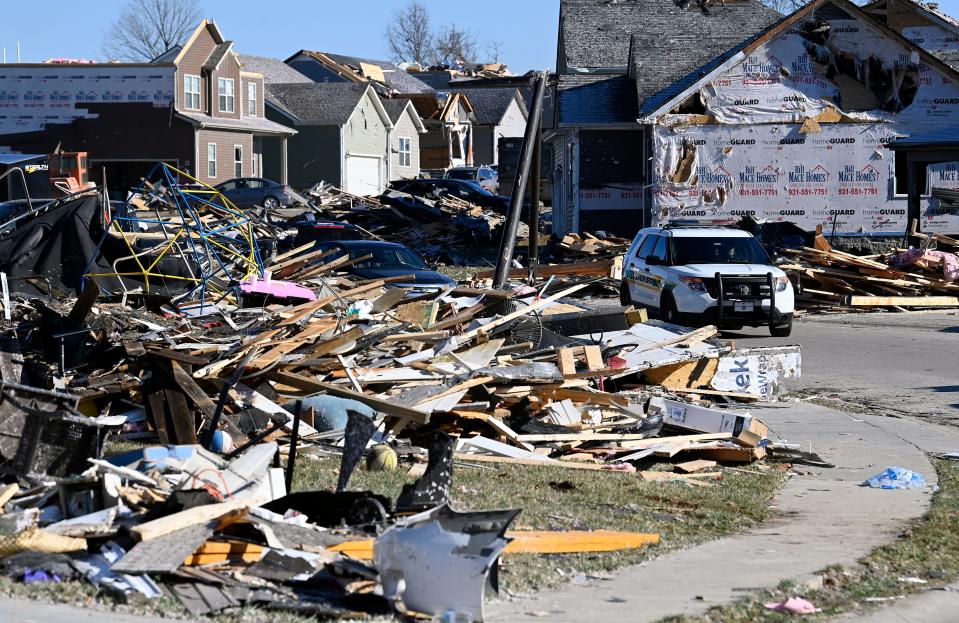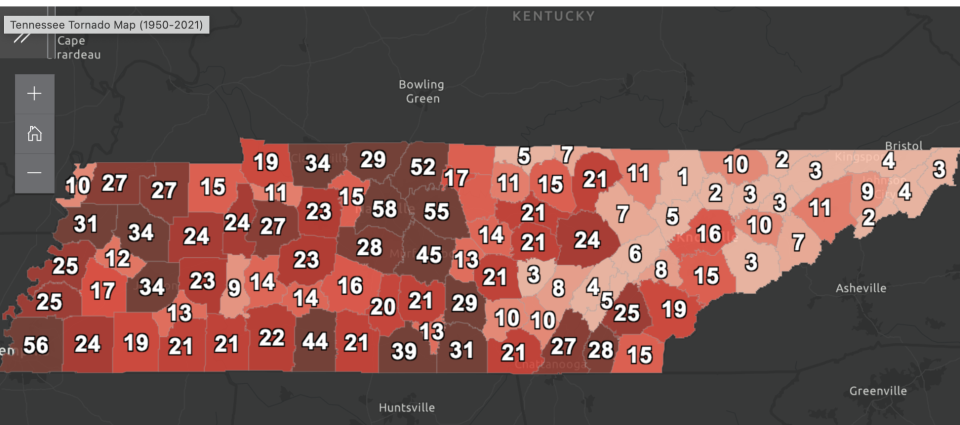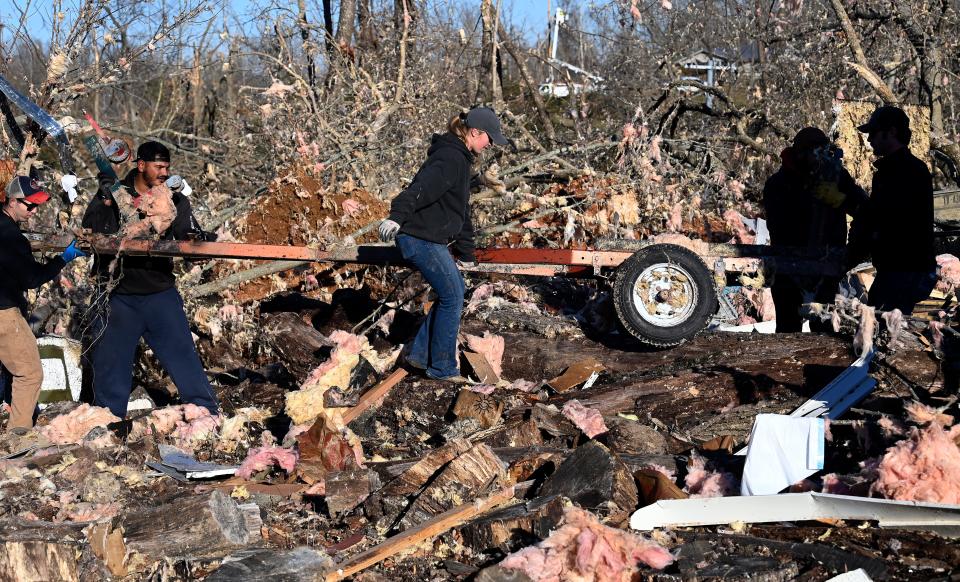How safe is your home? Recent tornadoes, shoddy construction expose dangers in Tennessee
When Angela Hayes and her family moved into their five-bedroom home on Henry Place in Clarksville, they assumed as a brand new house built in 2022 it was solid and sturdy.
But at times when the winds picked up, she said the home would rattle in a way that left Hayes and her husband, Elorn Dzidotor, a local pastor, feeling uneasy.
“The wind would blow up against the house and you would feel it shake and make this kind of cracking noise like no other house we had ever lived in, like it wasn’t stable on its foundation,” Hayes said. “We always felt nervous.”
On the evening of Dec. 9, Hayes was resting before her night shift as a labor and delivery nurse when an EF-3 rated tornado with winds of up to 150 miles per hour ripped through Clarksville.
The winds tore off the roof as Hayes and her extended family of seven rushed for cover. A side wall caved in and the entire home crumbled, she said, trapping them under piles of rubble. Her brother, Stephen Hayes, 34, did not survive.
Stephen Hayes was one of seven people, including two children, who died last month after a wave of powerful twisters carved path of destruction through Middle Tennessee, damaging hundreds of homes and businesses in Clarksville, Nashville, Madison, Hendersonville and Gallatin. The tornadoes traveled a combined 116 miles.

In the aftermath, Hayes wondered if her home had been properly built to withstand the winds, but she said it was hard to determine since the home was completely demolished.
She’s not the only one who is concerned.
National Weather Service, engineering experts raise worries
After the Clarksville tornado, the National Weather Service reported that some homes couldn’t handle the strength of the winds in part because of how they were attached to the foundations.
Krissy Hurley with the NWS said some homes that shifted off their foundations were only attached with straight nails, a much weaker option for builders to attach homes.
The NWS evaluates how damaged homes were constructed when it rates tornado strength on the Enhanced Fujita Scale.
In one case in Clarksville, a home was demolished while a maple tree in the front yard was unscathed. Hurley said she’s seen these signs of weak construction before.
“Unfortunately, a lot of times when people buy homes they don’t know exactly how these homes are attached,” she said.

Wondering how your home would fare in a tornado? Experts say it’s a valid concern.
Middle Tennessee tornadoes in recent years have exposed problems in old and newer homes, where the houses are not properly attached to the foundations, leading to the possibility of deadly outcomes.
And that’s just one of the concerns. Despite advancements in construction, most homes in Tennessee aren’t built to withstand extreme winds due to less-stringent building codes for wind speeds compared to hurricane-prone regions, experts said.
As Middle Tennessee’s population continues to grow, meteorologists and engineers say state and local leaders should push for stronger building codes to save lives.
In the meantime, experts say homeowners can take many precautions to better secure their homes and improve safety.
A perfect storm of danger
Tornado Alley in the Great Plains has long been known for its twisters, but the deadliest cases actually occur in the Southern states, due to what experts say is a perfect storm of danger.
Greater density, a higher number of mobile and manufactured homes, lack of building codes in rural areas and a higher rate of nocturnal tornadoes all play a role in the tornado region known as Dixie Alley.
In Tennessee, Davidson County holds the record for most tornadoes in the state, with 58 hitting the county since 1950, according to the National Weather Service. Shelby County came in second with 56 twisters, followed by Wilson County with 55 and neighboring Sumner with 52.

Though Middle Tennessee has some of the highest rates of tornadoes, concerns have surfaced over home constriction in recent years.
A study after the deadly March 2020 tornadoes surveyed damage in Nashville, Mt. Juliet, Lebanon and Cookeville and found “glaring deficiencies” in the load path to the foundations for many modern, code-compliant single-family homes. A load path connects every piece of the home's structure from the roof to foundation, like links in a chain.
David Roueche, a civil engineering professor at Auburn University who participated in the study as part of the Structural Extreme Events Reconnaissance network (StEER), said some homes were simply resting on their foundation with no attachment or reinforcement, leaving them vulnerable to upward wind gusts.
Roueche said a continuous load path that connects the home from the roof to the foundation is critical in strong winds.
“We use the analogy of a chain for the load path,” he said. “You’re only as strong as the weakest link, and unfortunately we see that a lot of the time.”
Experts say it can be hard to determine whether your home is properly secured to its foundation, and even harder to fix if the home has already been built.
But the consequences can be deadly.
Deadly consequences, lawsuits over building work
In Rutherford County, Angie Walker, 41, was killed in November 2018 when her home flipped off its foundations in an EF-2 tornado, landing 100 feet away.
The family later sued the home builder alleging the house, built in 2017, was not properly anchored to the foundation. The case later settled.
Brandon Bass, a Nashville-based personal injury lawyer who represented the Walker family, declined to comment specifically about the case due to the settlement. But in his research for the case, he said he discovered some concerning construction practices in the region.
Bass said there were cases where brick masons were reportedly cutting corners by filling concrete foundation blocks with dirt and gravel rather than using cement to secure anchor bolts, because they didn’t want to wait for cement to dry. As a result, the homes were not properly anchored to the foundation.

The International Residential Building Code, which is followed by most municipalities, requires that bolts be extended at least seven inches into concrete or grouted cells.
But Bass said code inspectors would likely miss it, unless they were diligent.
“There are some extremely diligent inspectors where they will grab a light hammer and tap the side of the block to see if it’s still hollow, but from my understanding from talking to experts is that those inspectors are few and far between,” he said. “There’s no telling how much of it is out there, and that is a huge problem.”
Construction in Clarksville
In the most recent tornado in Clarksville, the homes that shifted off their foundations were built in the 1960s in one neighborhood, and between the late 1990s and mid-2000s in another section.
Some builders also reportedly used adhesive tape to help secure the foundation.
Clarksville’s building codes in the mid-1990s required homes to be anchored at least six inches into concrete foundations with half inch bolts.
Justin Crosby, interim director of the city’s Building & Codes Department, in an email said he hasn’t seen homes that were attached to their foundations with tape, but he urged residents to reach out to the city’s code department.
"We do not have any open code cases for homes that were damaged by the storm that may have had code violations,” he added.
As Clarksville’s population booms, Blain King, a certified home inspector with Red Cedar Inspections, said he has looked at many new homes in the area, and for the most part they’re well constructed. Though he has seen some cases for concern.
“It all boils down to how closely the builder watches their subcontractor when things are being put together,” he said.
King said he’s inspected homes that were damaged in the most recent tornado and many suffered major damage even with solid foundations.
“This demonstrates that even a properly constructed home can be damaged with 130 mph rotating forces from a tornado,” he said.
Building stronger in Tennessee
Tennessee previously followed the International Residential Code from 2012 that required buildings to withstand 90 mph winds.
Lawmakers in recent years have strengthened the standards to follow the more current 2018 International Residential Code guidelines, with municipalities allowed to adopt their own, stronger building standards.
Some cities, like Nashville, Clarksville and Cookeville, now have codes that require homes to withstand 115 mph winds, up from 90 mph. The Nashville Metro Council adopted the change after the March 3, 2020 deadly tornado.
While the stronger building codes for wind speed are a start, experts say it’s not enough to withstand an EF-2 tornado with average wind speeds of 111 to 135 mph. More than 90 percent of tornadoes in the region are EF-2 or weaker, but that doesn’t mean the buildings should be weak, they said.

“The heart of the problem is the fact that in the interior portion of the country we choose to design for a much lower wind speed than the coast,” Roueche said. “With the latest design standards at 105 and 110 mph, it’s no surprise you’re going to get significant damage in an EF-2.”
Stephen Strader, a Villanova University professor who specializes in hazards and disaster geography, said the technology is available to build stronger homes, but builders, homeowners and local leaders need to push for the change.
“For people who don’t have a good place to shelter, it comes down to how well their home was built in terms of survivability," he said. "And what we’re finding more and more is that the building standards are too low. We think the latest and greatest is going to be strong, and that isn’t always the case.”
Protecting your home
On a positive note, Leslie Chapman-Henderson, president of the Federal Alliance for Safe Homes, said more people are embracing advancements in building technology as we learn more about tornadoes.
“In the past we labored under the old thinking that there’s nothing you can do if a major tornado hits a home, but in today’s world nothing could be further from the truth,” she said. “The U.S. has a very significant tornado problem and that’s the bad news, but the good news is we can absolutely and affordably build to withstand 97% of tornadoes we experience.”
Chapman-Henderson said certified safe rooms have jumped in popularity in recent years and are now more affordable and easier to install.
Another major step where people can protect themselves is through their garage door, which is typically the weakest structural point of the house, she said. Chapman-Henderson said that more than 90% of structure failures start through the garage door as wind pressure fills the home like a balloon.
Chapman-Henderson said there are different levels of garage door reinforcement that range in cost, but one of the easiest steps is just making sure the connection for the garage door is secure.
“That simple step alone could help you,” she said.
While it’s good for homeowners to take extra precautions, Roueche said there should be more accountability for contractors, building inspectors and lawmakers to ensure homes are safely built.
“When you buy a home, you just assume it’s going to be built to code and that it’s all going to be done properly, but as a community we have to demand that our homes are built properly and that inspectors know what to look for,” he said. “Otherwise, problems will keep happening in brand new homes with zero repercussions.”
Hayes said she and her family are pushing forward after losing everything in the Clarksville tornado. Hayes said the family is now renting a home in the area and she recently returned to work.
They plan to eventually buy another home, but for now they’re working on healing.
“We are so traumatized when it comes to repurchasing a house and what to look for and what is safe,” she said. “It’s a lot to think about.”
This article originally appeared on Nashville Tennessean: Tennessee tornadoes: Storms, poor home construction point to dangers

